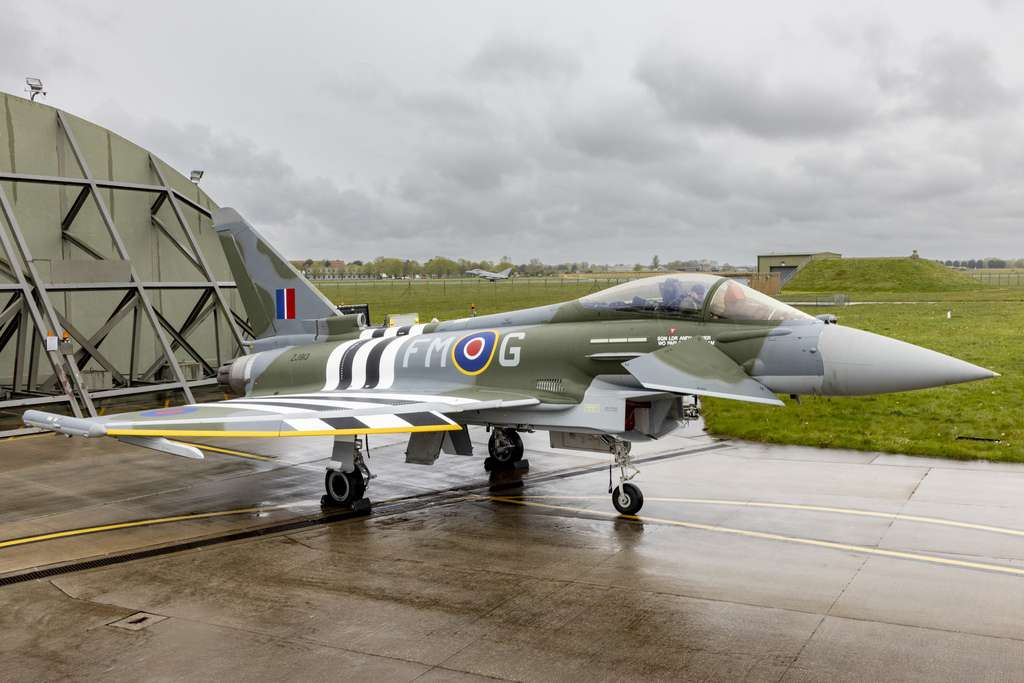In a stirring tribute to the 80th anniversary of D-Day, the RAF Typhoon Display Team has unveiled a newly painted aircraft for the 2024 season.
Taking center stage at airshows across the UK, will be special Typhoon (ZJ913, nicknamed “Moggy”). It will be a powerful symbol of the team’s heritage and the legacy of those who fought for freedom in World War II.
The aircraft’s striking design draws inspiration from a 1944-era Hawker Typhoon of 257 Squadron. This was the aircraft flown by Pilot Officer Denzel Jenkins on D-Day itself (marked with the code FM-G).
This “Day Fighter” scheme features the RAF Tactical Recognition Flash alongside prominent D-Day invasion markings. This will create a visually impactful connection to the past.

Pilot Officer Jenkins, who began his service as an airman, rose through the ranks to become Officer Commanding (OC) of 257 Squadron. His bravery and skill were recognized with the Distinguished Flying Cross.
Flight Lieutenant Turnbull from 29 Squadron RAF will take the helm of “Moggy” for the 2024 display season.
Displays will thrill audiences with a combination of cutting-edge Typhoon technology and a nod to the aircraft’s rich history.
This special paint scheme adds a unique layer of depth to the Typhoon Display Team’s performances. It will ensure a truly memorable season that honors the sacrifices made during D-Day.

The original 1944 Paint Scheme
The distinctive black and white stripes seen on Allied aircraft during D-Day weren’t a permanent paint scheme. Rather, they were temporary markings specifically introduced to address a critical issue: avoiding friendly fire.
These markings, nicknamed “invasion stripes,” were hastily applied to aircraft in the days leading up to the invasion.

Allied forces were anticipating a massive operation with a complex mix of air, land, and sea forces operating in close proximity. The concern was that with the chaos of battle, there was a high risk of Allied anti-aircraft fire mistakenly targeting their own aircraft.
The black and high-contrast white stripes provided a clear visual identification for Allied forces on the ground.
This helped them distinguish friendly aircraft from enemy planes, hopefully minimizing incidents of accidental friendly fire.
The invasion stripes were a relatively simple yet effective solution to a potentially devastating problem.
While not a permanent feature, they became a significant symbol of D-Day. They also represented the immense logistical challenges faced by the Allied forces.

Remembering D-Day 1944
The D-Day mass operation took place on June 6, 1944. It was the codename for the start of the Allied invasion of Normandy during World War II. It remains the largest seaborne invasion in history.
Here’s a breakdown of the D-Day operation:
- Part of Operation Overlord: D-Day was actually just the first phase of a larger operation called Operation Overlord. This aimed to liberate Western Europe from Nazi control.
- Massive Allied Force: The invasion involved a staggering number of troops and resources. Over 5,000 ships and landing craft carried nearly 160,000 soldiers across the English Channel on D-Day itself. From there, millions more arrived in the following months.
- Airborne Landings: Prior to the beach landings, over 1,200 Allied aircraft dropped paratroopers behind enemy lines to disrupt German defenses.
- Five Beaches: The amphibious assault targeted five beaches in Normandy codenamed Utah, Omaha, Gold, Juno, and Sword.
- Fierce Fighting: German forces were prepared for an invasion, and heavy fighting ensued on all the beaches. Omaha Beach, in particular, saw significant Allied casualties.
- Turning Point: Despite the initial difficulties, the Allies managed to secure a foothold in Normandy. This marked a major turning point in the war. It pushed back German forces and opening a new front in Western Europe.
We remember D-Day for the immense courage and sacrifice of the Allied troops who participated in the operation. It paved the way for the eventual liberation of France and the eventual defeat of Nazi Germany.

Click the banner to subscribe to our weekly newsleter.

Click the photo to join our WhatsApp channel so then you can stay up to date with everything going on in the aviation industry!









